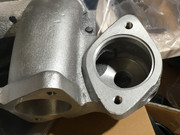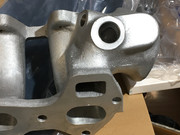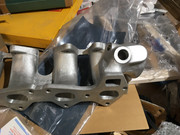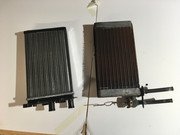Im hoping i can still get away using the original water pump,i know there not the best but im changing so much just to try and get this EFI to work one less thing is a bonus
Dave
Dave, the heater plumbing is an additional circuit running in parallel to the cooling circuit.new to this wrote: ↑Tue May 12, 2020 10:28 pm thats a better way of plumming it, but you will need some sort of by pass ,other wise if ive got this right if you turn the heater off the car would over heat,and i take it you just block off the original supply from the inlet manifold
I would like one of those mangolet manifold but there dear, and then ive still got to drill holes in it for the injector bungs
dave[/color]



You are correct Dave, I could use a thermostat in the manifold and a bypass hose from there.new to this wrote: ↑Thu May 14, 2020 1:56 pm This bypass thing has been my biggest problem
Im a bit confused you said your not using the thermostat in the housing , its already there why not use it , i was trying to copy the original manifold setup ,at the base of the thermostat theres a foot , i was trying to incorporate that as well,but its been a real pain,
How would i plum/fit a remote thermostat housing
Steve, I have learned some more about the causes of poor heater performance
I'm pretty sure that was what was said on page 1!The causes being clogging and internal corrosion.




During my early-childhood in the late-1950s & early-1960s, when we lived in Dundee, Scotland (not to be confused with Dundee, South Africa, where it's relatively warm!), my father's then Morris 8 Series E, didn't have any heating, demisting or defrosting system at all. It was quite chilly travelling the 420 miles from Dundee to London during the Chrismas holidays to visit my grandparents. Oh for the luxury of a Triumph Toledo 1300 "HL Special" heating, demisting & defrosting system.

I am not sure what EWC is, as it is not defined earlier in this topic thread, but I suspect that it might stand for "Evans Waterless Coolant"!?! So far as I am aware, the only advantage of using Propylene Glycol (or propane-1,2-diol, to give its proper IUPAC name) rather than Ethylene Glycol, is its low toxicity, but otherwise I know of no other advantages of using it as a heat-transfer fluid.MIG Wielder wrote: ↑Tue May 12, 2020 5:37 pm Hi Ian, I think the basic problem here is the use of EWC as the coolant.
Just to recap on what I wrote for the mag some time ago I deduced EWC was based on Propylene Glycol.
When used as a vehicle coolant its physical properties have 3 problems.
1. The specific heat is much lower than that of water.
Water = 4.18 J / g / K.
EWC = 2.51 J / g / K.
So for a given heat input EWC will run hotter.
2. The Thermal Conductivity is much lower.
Water = 0.606 W / m.K
EWC = 0.206 W / m.K
3. The viscosity is a lot higher than water.
Water = 0.5 Cp at 60 Deg C.
EWC = 8.4 Cp at 60 Deg C.
So to give a specified flow rate the pump pressure must be higher.
Or given a specific pump pressure, the flow rate is lower.
So, all other things being equal the engine will always run hotter with EWC.
And the heater will run cooler.
( The big advantages of the non-pressurisation , and non-corrosive properties are why I use it though. ).
So I did some maths around the heater matrix. See .pdf.
There are a number of assumptions but from Case 1 with an assumed flow rate of 100 gms /sec = 100cc sec or ~ 6L min and a heater inlet temp of 80 deg C and an outlet at room temp of 20 deg C the matrix is dissipating 25,080 Joules.
Case 2 is where the water is swapped for EWC and I assume the same inlet and outlet temps; and flow rate . So best case you will only liberate 15,060 Joules. BUT… EWC is more viscous so flow rate will be lower, and the thermal conductivity is lower which I haven't accounted for in this simple calc; But the inlet temp will be higher. Even so much less heat output.
Case 3 . Attempts to answer the question . How hot must the engine be with the same flow rate, and the same temp; drop to give the same heat output.
This comes out at nearly 120 Deg C. Far too hot for a slant 4.
So what are the solutions …
1. Let the engine temp rise. In Summer mine runs at 90 deg C
2. Yes, increase the matrix size.
3. Increase the flow rate, perhaps by use of the Davis-Craig mini motor-bike electric water pump controlled by the heater motor switch. Which is what I have on CWL.
HTH,
Tony.
You may well be correct Ian, there does seem to be wide variation in Dolomite heater performance. I remember also, my days of running MkII Ford Zodiacs which had the heater matrix mouted higher than the radiator cap. These were a swine to keep working and had a pretty poor output for what was, in it's day, a luxury car. I took to keeping a spare assembly which was easy to change (4 easily accessible bolts and 2 hoses and job done) as turning it off for the summer meant the matrix was silted up when autumn rolled round and you needed it again.sprint95m wrote: ↑Fri May 15, 2020 9:24 amSteve, I have learned some more about the causes of poor heater performance
and more particularly why it can vary from car to car. (This is from people who repair heaters.)
The causes being clogging and internal corrosion.
Inevitably the silt from the engine will gather in the heater matrix.
This will set like concrete in time and the useable volume within the matrix is reduced.....
and no amount of back flushing will shift it.
Another problem is corrosion of the divider plate, once it becomes holed, coolant will pass from inlet
to outlet without going through the matrix at all. As the hole enlarges less coolant goes through the matrix....
Ian.